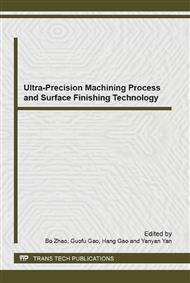p.183
p.187
p.191
p.195
p.199
p.203
p.208
p.213
p.217
The Optimization of Termination in Combined Technique of Magnetorheological Finishing and HF Etching for Laser-Induced Damage Threshold High-Efficiency Improving of Fused Silica
Abstract:
The developing high-power laser systems are requiring higher laser-induced damage threshold (LIDT) and fabrication efficiency of fused silica optical elements. To solve these problems, MRF polishing and HF etching have been combined utilized wiping and passivating structural defects as well as removing impurities. Furthermore, the LIDT improvement is dependent greatly on the corporation of processes. But the LIDT improving mechanism is partly ambiguous yet, that may lead to random or experimental parameter choice and ultimately generate unsatisfied results. Consequently, this paper focuses on the termination mechanism of the process. Atom Force Microscope (AFM) measurement, finite difference time-domain (FDTD) simulation and LIDT test will be utilized to analysis and validate the optimization theoretically and practically. Finally, in one side, the LIDT value of optimized-terminated sample is 16.7J/cm2, which is about the same level (even 3.7% higher) as that of the over-etched one. In another side, the etching process time could be shorted by 32% using the optimized method.
Info:
Periodical:
Pages:
199-202
Citation:
Online since:
October 2014
Authors:
Price:
Сopyright:
© 2014 Trans Tech Publications Ltd. All Rights Reserved
Share:
Citation:


